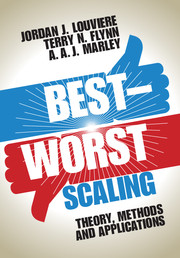Book contents
- Frontmatter
- Contents
- List of figures
- List of tables
- List of contributors to application chapters
- Preface
- Acknowledgments
- Theory and Methods
- Applications: Case 1
- Applications: Case 2
- Applications: Case 3
- 13 The stability of aggregate-level preferences in longitudinal discrete choice experiments
- 14 Case 3 best-worst analysis using delivered pizza and toothpaste examples
- 15 Using alternative-specific DCE designs and best and worst choices to model choices
- References
- Subject index
- Author index
13 - The stability of aggregate-level preferences in longitudinal discrete choice experiments
from Applications: Case 3
Published online by Cambridge University Press: 05 October 2015
- Frontmatter
- Contents
- List of figures
- List of tables
- List of contributors to application chapters
- Preface
- Acknowledgments
- Theory and Methods
- Applications: Case 1
- Applications: Case 2
- Applications: Case 3
- 13 The stability of aggregate-level preferences in longitudinal discrete choice experiments
- 14 Case 3 best-worst analysis using delivered pizza and toothpaste examples
- 15 Using alternative-specific DCE designs and best and worst choices to model choices
- References
- Subject index
- Author index
Summary
13.1 Introduction
The purpose of this chapter is to investigate the temporal stability of Case 3 best-worst scaling – that is, discrete choice experiments. Temporal stability matters, because, if the individuals who participate in DCEs significantly alter their preferences for the same choice options over time, it suggests that some time-dependent or event-associated process underlies the changes or that the participants do not or cannot produce reliable or accurate choices. We studied temporal stability by conducting four waves of DCEs for three product categories (toothpaste, laundry detergent and delivered pizzas). The survey was administered to a random sample of members of the Pureprofile online panel in Australia; the screening criterion was the purchase or use of the product to which they were assigned in the previous three to six months. The design of the DCEs was identical for each of the three products, the only differences being the particular set of attributes that pertained to each product. To anticipate our results, we find very strong aggregate preference stability across all three products.
Case 3 BWS focuses on discrete choice experiments in which the experimental task is (at a minimum) to identify the “best” and “worst” options in each choice set. DCEs were pioneered by Louviere and Woodworth (1983), and are widely used to model sample-, segment- and/or market-level preferences and choices in marketing and other fields. After almost 30 years of applications and many academic research papers on DCEs, surprisingly few papers have investigated the stability of DCE choices over time. Indeed, most external (real-market) prediction tests in marketing and other fields involved relatively short time lags between DCEs and market observations (though see McFadden and Reid, 1975), with some other tests of “back-casting” to prior observations such as scanner panel choices (for example, Swait and Andrews, 2003). So, despite academic and commercial interest in whether DCE choices are stable over repeated administration in panel or cross-sectional samples, there is little work on this topic.
When DCEs are used to forecast the likely uptake or choices of new products and/or technologies, there are time lags between DCE data collection and market introduction. Likewise, there are lags (typically shorter) between DCEs and introductions of product variants and/or changes in marketing, management or public policy manifest as changes in market offerings.
Information
- Type
- Chapter
- Information
- Best-Worst ScalingTheory, Methods and Applications, pp. 265 - 277Publisher: Cambridge University PressPrint publication year: 2015
Accessibility standard: Unknown
Why this information is here
This section outlines the accessibility features of this content - including support for screen readers, full keyboard navigation and high-contrast display options. This may not be relevant for you.Accessibility Information
- 3
- Cited by
